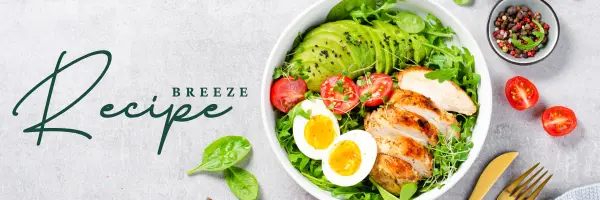Ultimate Salmon Loaf Recipe with a Crispy Top
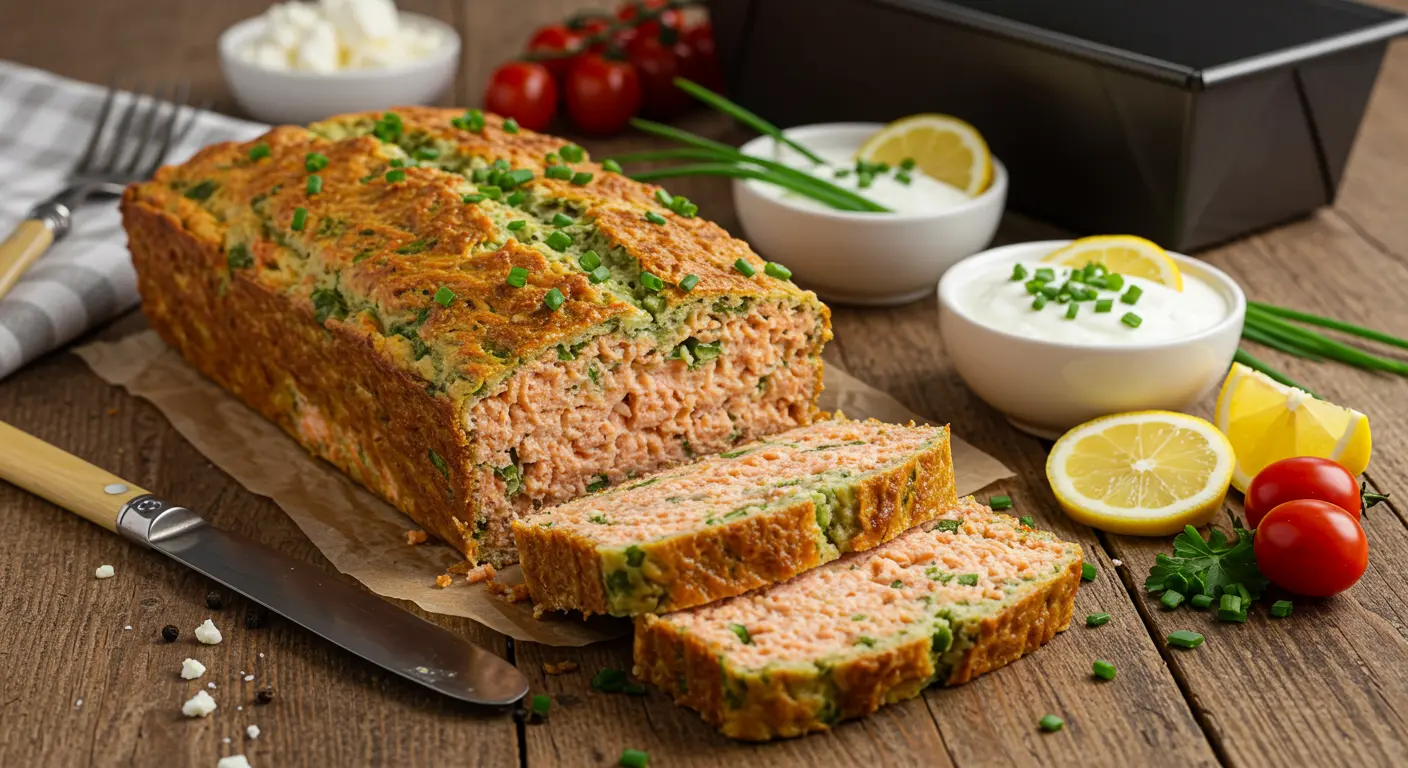
Tired of dry, crumbly salmon loaf? Remember that comforting, classic dish grandma used to make? This recipe brings back all that delicious nostalgia, without the guesswork.
We’ve perfected the ratios and techniques to guarantee a salmon loaf that’s incredibly moist, packed with flavor, and surprisingly easy to make. Get ready for your new family favorite!
Table of Contents
Why This is the BEST Salmon Loaf Recipe:
- Perfectly Moist Every Time: Our specific ingredient balance prevents dryness.
- Incredibly Flavorful: Uses fresh herbs, sautéed vegetables, and a touch of Dijon for depth.
- Super Easy to Make: Simple steps perfect for weeknights or beginners.
- Versatile: Great options for using canned or fresh salmon.
- Tried & Tested: Perfected through multiple rounds of testing for reliable results.
Quick Salmon Loaf Recipe Card
- Prep Time: 15 minutes
- Cook Time: 45 minutes
- Total Time: 1 hour
- Difficulty: Easy
- Servings: 8 slices
Ingredients You’ll Need
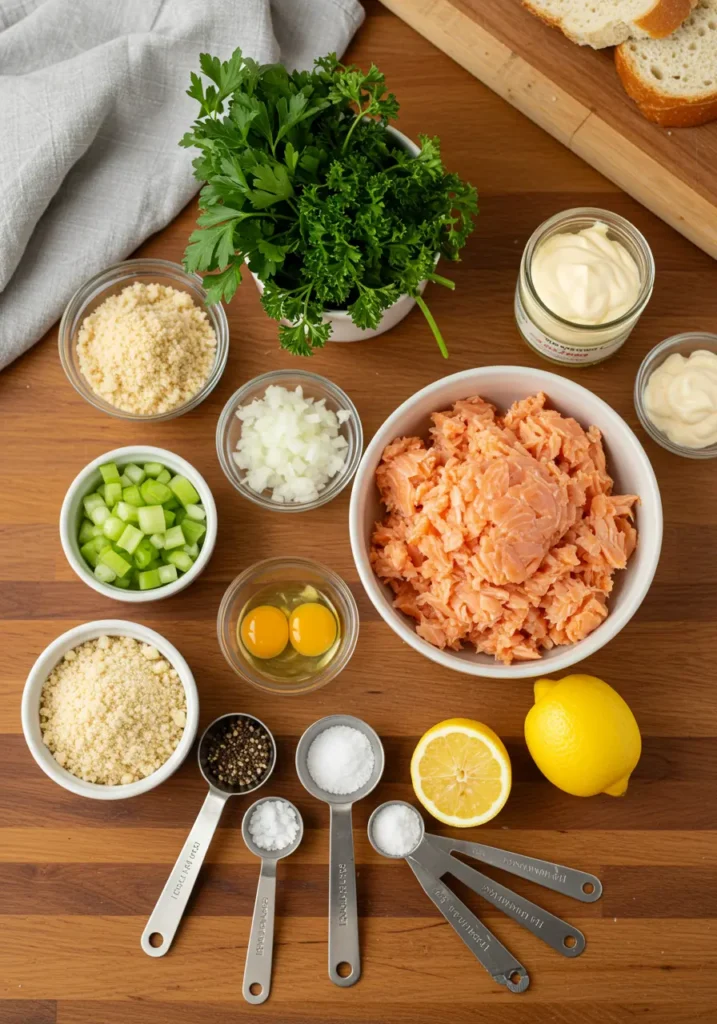
Here’s what you need to gather for this delicious salmon loaf:
- 1 (14.75 ounce) can Pink Salmon, drained and flaked (or see notes for fresh salmon)
- 1 cup Breadcrumbs (Panko preferred for texture, or crushed crackers/oats – see notes)
- 1/2 cup Finely Chopped Onion
- 1/2 cup Finely Chopped Celery
- 1 Large Egg, lightly beaten
- 1/4 cup Milk (or unsweetened non-dairy milk)
- 2 Tablespoons Fresh Parsley, chopped (or 2 tsp dried)
- 1 Tablespoon Lemon Juice
- 1 teaspoon Dijon Mustard (optional, adds depth)
- 1/2 teaspoon Salt (or to taste)
- 1/4 teaspoon Black Pepper
- Optional Glaze: 3 tablespoons ketchup mixed with 1 teaspoon brown sugar
Ingredient Notes: Panko breadcrumbs create a lighter texture than regular breadcrumbs, but either works well. If using fresh salmon instead of canned, cook about 1 pound of fresh salmon, remove skin and bones, then flake it for this recipe. While the texture might vary a bit, the taste will remain just as delightful.
Equipment Needed
- Large Mixing Bowl
- 9×5 inch Loaf Pan
- Small Skillet (for sautéing vegetables)
- Measuring Cups and Spoons
- Instant-read Thermometer (optional but helpful)
How to Make the Best Salmon Loaf (Step-by-Step)
Making this salmon loaf is straightforward. Follow these simple steps:
- Preheat & Prep: Preheat your oven to 375°F (190°C). Lightly grease a standard loaf pan (approx. 9×5 inches).
- Sauté Aromatics (Optional but Recommended): Heat a teaspoon of oil in a small skillet over medium heat. Sauté the finely chopped onion and celery until softened, about 5-7 minutes. Let cool slightly. This extra step develops rich flavor and ensures your vegetables blend perfectly into the loaf.
- Combine Wet Ingredients: In a large bowl, lightly beat the egg. Whisk in the milk, lemon juice, Dijon mustard (if using), salt, and pepper until well combined.
- Add Salmon & Solids: Add the drained and flaked salmon, sautéed vegetables (if using), breadcrumbs, and fresh parsley to the bowl. Make sure to check the salmon for any small bones that might have been missed.
- Mix Gently: Combine the ingredients using gentle folding motions until they are just mixed. Do not overmix, as this can make the loaf tough. The mixture should hold together when pressed but still remain somewhat light.
- Form the Loaf: Transfer the mixture to the prepared loaf pan and gently press it into an even layer. Don’t pack it too tightly, which could result in a dense final product.
- Optional Glaze: If using a glaze, mix the ketchup and brown sugar together and spread evenly over the top of the loaf. This creates a delicious caramelized crust as it bakes.
- Bake: Bake for 40-50 minutes, or until the loaf is firm to the touch and lightly golden brown. An instant-read thermometer inserted into the center should register 145°F (63°C).
- Rest: Let the salmon loaf rest in the pan for 5-10 minutes before slicing and serving. This helps it hold its shape when cut and allows the flavors to settle.
Tips for Success: Avoiding Common Pitfalls
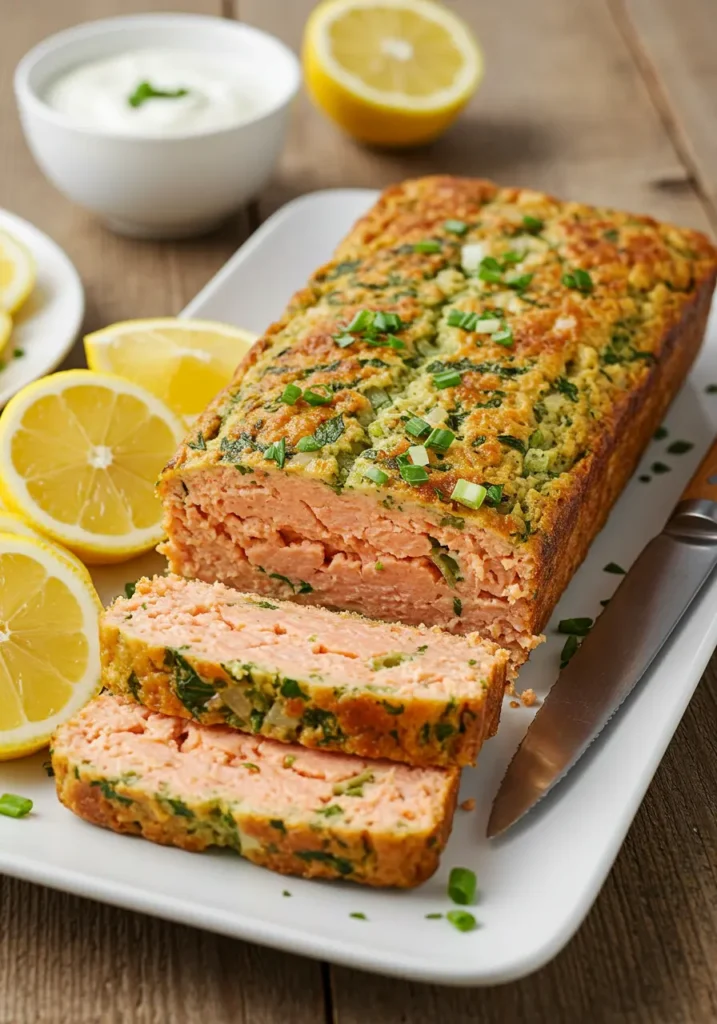
Want to guarantee a perfect salmon loaf every single time? Follow these essential tips:
How to Keep Your Salmon Loaf Moist:
The key to a moist salmon loaf is balancing wet and dry ingredients. Don’t skimp on the egg and milk, which provide necessary moisture. Also, avoid overbaking—once the internal temperature reaches 145°F, remove it from the oven even if it doesn’t look as brown as you’d expect.
Choosing the Right Salmon:
Canned salmon offers convenience and a good source of calcium due to its soft bones. When using canned salmon, it is important to drain it well to remove extra liquid. For fresh salmon, a medium-fat variety like sockeye works best—extremely lean cuts might produce a drier loaf.
Binder Options (Breadcrumbs vs. Crackers vs. Oats):
Panko breadcrumbs create the lightest texture. Regular breadcrumbs work well but yield a slightly denser result. Crushed crackers (like saltines) add nice flavor but can make the loaf saltier, so adjust seasoning accordingly. Oats create a heartier texture and are great for a healthier twist.
Why Sautéing Vegetables Matters:
Taking the time to sauté onions and celery removes excess moisture and develops their natural sweetness. Raw vegetables release water during baking, which can make your salmon loaf soggy, and they might remain slightly crunchy in the finished dish.
Getting the Perfect Texture (Not Mushy!):
Strike the right balance with your binders. Too many breadcrumbs make the loaf dry; too few make it fall apart.The mixture’s consistency is ideal when it can be compressed and retains its shape, without containing excessive moisture. Let the loaf rest after baking to set properly.
Checking for Doneness:
Visual cues include a golden-brown top and firm edges that pull slightly away from the pan. For certainty, use a thermometer—145°F ensures food safety while preventing overcooking.To prevent the top from over-browning while the center finishes cooking, loosely cover with aluminum foil.
Delicious Salmon Loaf Variations
Feel like mixing it up? This recipe is wonderfully adaptable. Try these tested variations:
Gluten-Free Salmon Loaf:
Replace breadcrumbs with gluten-free alternatives like crushed rice crackers, certified gluten-free oats, or commercial gluten-free breadcrumbs. The binding properties differ slightly, so you might need to adjust the milk quantity—start with a bit less.
Spicy Salmon Loaf:
Add one finely diced jalapeño (seeds removed for moderate heat) to your sautéed vegetables. Mix in 1/2 teaspoon of cayenne pepper or 1 tablespoon of hot sauce with the wet ingredients. A dash of smoked paprika adds wonderful depth to the spicy profile.
Lemon-Dill Salmon Loaf:
To enhance the lemon flavor, use 2 tablespoons of lemon juice and 1 teaspoon of lemon zest. Substitute the parsley with 2 tablespoons of fresh dill. This bright, herbal version pairs beautifully with a simple yogurt-dill sauce (mix 1/2 cup Greek yogurt with 1 tablespoon each of lemon juice and chopped dill).
Smoked Salmon Loaf:
Replace 1/4 of the regular salmon with flaked smoked salmon for a subtle smoky flavor. Reduce the added salt, as smoked salmon brings its own saltiness. Add 1 tablespoon of capers for an extra dimension of flavor that complements the smokiness.
Veggie-Loaded Salmon Loaf:
Add 1/4 cup each of finely diced red bell pepper and shredded carrots to the sautéed vegetable mix. Fold in 1/2 cup of thawed frozen peas at the final mixing stage. This colorful version is not only visually appealing but packs extra nutrition.
What to Serve with Salmon Loaf
Complete your comforting meal with these perfect pairings:
- Creamy mashed potatoes
- Roasted asparagus with lemon
- Steamed green beans with butter and almonds
- Light mixed greens salad with vinaigrette
- Buttery peas with fresh mint
Simple Dill Sauce for Salmon Loaf
This quick sauce elevates your salmon loaf to restaurant quality:
- 1/2 cup sour cream or Greek yogurt
- 1 tablespoon fresh dill, chopped
- 1 teaspoon lemon juice
- 1/4 teaspoon garlic powder
- Salt and pepper to taste
Just mix everything together in a small bowl. Pop it in the fridge for at least 15 minutes so all the flavors can blend before you serve it.
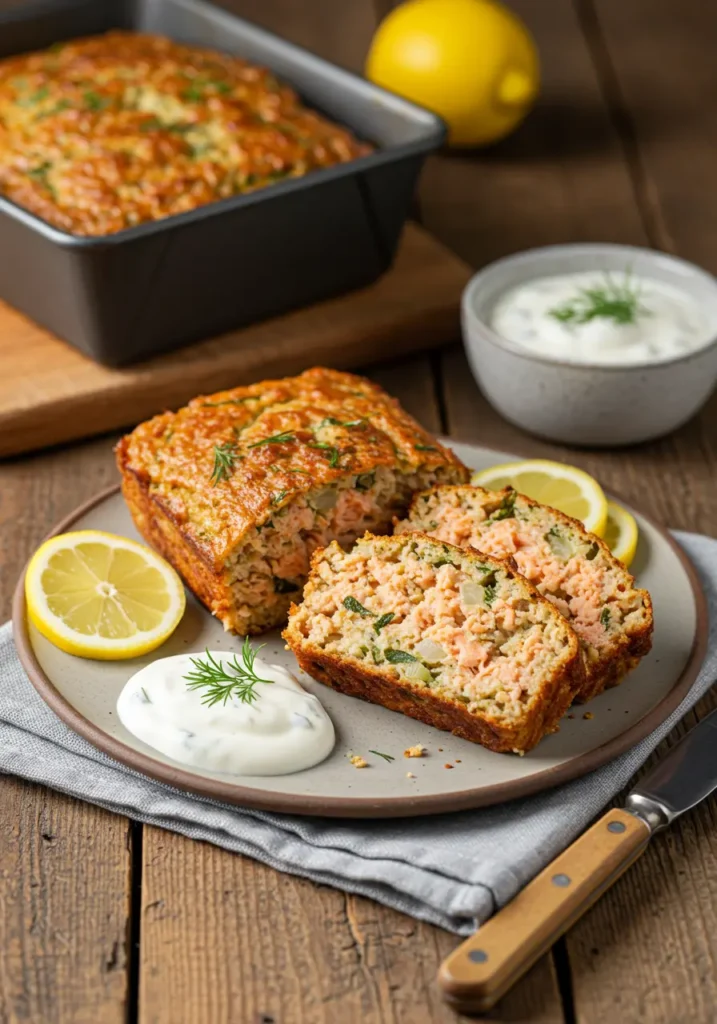
Salmon Loaf FAQs (Frequently Asked Questions)
How long does leftover salmon loaf last in the refrigerator?
Leftover salmon loaf can be stored in a sealed container in the fridge for a maximum of 3 days. Make sure it has cooled completely before refrigerating to prevent condensation that could make it soggy.
Can I freeze salmon loaf?
Yes! Salmon loaf freezes beautifully. For best results, cool completely, then wrap individual slices or the entire loaf (minus the pan) tightly in plastic wrap followed by aluminum foil or place in a freezer-safe container. Freeze for up to 3 months. Thaw overnight in the refrigerator before reheating.
What’s the best way to reheat salmon loaf?
For optimal texture, it’s best to reheat in a 325°F oven for approximately 15 minutes, or until heated through. While microwave reheating (1-2 minutes at medium power) is a quicker alternative, it might slightly change the texture. Add a small pat of butter on top before reheating to help maintain moisture.
Can I use fresh salmon instead of canned?
Absolutely! Flake about 1 pound of fresh salmon after cooking it to 145°F and removing the skin and bones. Allow the flaked salmon to cool entirely before using it in the recipe. Fresh salmon often creates a more delicate flavor and texture in the final loaf.
Storage, Freezing, and Reheating Instructions
Can I make salmon loaf ahead of time?
Yes, you have two options: Prepare the mixture and refrigerate unbaked for up to 24 hours before baking (may need 5-10 extra minutes in the oven), or bake completely, cool, refrigerate, and reheat when needed. The flavors often improve after a day of melding.
Why is my salmon loaf falling apart?
Common causes include insufficient binding ingredients (try adding another egg), too much moisture (drain salmon very well), or not allowing it to rest after baking. The resting period of 5-10 minutes is crucial for the proteins to set properly.
Is salmon loaf healthy?
Yes! Salmon loaf is packed with protein, heart-healthy omega-3 fatty acids, and vitamins. To make it even healthier, use whole grain breadcrumbs, increase the vegetables, and opt for a lighter topping instead of the ketchup glaze.
Nutrition Information
Nutrition information is estimated based on ingredients listed and may vary. Consult a nutritionist for precise information.
- Calories: Approximately 250 per serving (1/8 of loaf)
- Protein: 18g
- Carbohydrates: 15g
- Fat: 14g (mostly healthy omega-3 fatty acids)
- Fiber: 1g
- Sodium: 480mg
Did you make this Salmon Loaf recipe? We’d love to hear how it turned out! Leave a comment and rating below and let us know any variations you tried!
